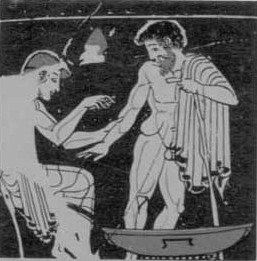Yes we have a blood-letting instrument at our Relic Home. And it looks much like this:
From Wikipedia, the free encyclopedia
| Bloodletting | |
|---|---|
 Bloodletting in 1860 | |
| MeSH | D001815 |

Bloodletting (or blood-letting) is the withdrawal of blood from a patient to prevent or cure illness and disease. Bloodletting, whether by a physician or by leeches, was based on an ancient system of medicine in which blood and other bodily fluids were regarded as "humours" that had to remain in proper balance to maintain health. It is claimed to have been the most common medical practice performed by surgeons from antiquity until the late 19th century, a span of over 2,000 years.[1] In Europe, the practice continued to be relatively common until the end of the 19th century.[2] The practice has now been abandoned by modern-style medicine for all except a few very specific medical conditions.[3] In the overwhelming majority of cases, the historical use of bloodletting was harmful to patients.[4]
Today, the term phlebotomy refers to the drawing of blood for laboratory analysis or blood transfusion.[5] Therapeutic phlebotomy refers to the drawing of a unit of blood in specific cases like hemochromatosis, polycythemia vera, porphyria cutanea tarda, etc., to reduce the number of red blood cells.[6][7] The traditional medical practice of bloodletting is today considered to be a pseudoscience.[8]
In the ancient world[edit]


Passages from the Ebers Papyrus may indicate that bloodletting by scarification was an accepted practice in Ancient Egypt.[9][10][11] Egyptian burials have been reported to contain bloodletting instruments.[12] According to some accounts, the Egyptians based the idea on their observations of the hippopotamus,[13] confusing its red secretions with blood and believing that it scratched itself to relieve distress.[14][15]
In Greece, bloodletting was in use in the 5th century BC during the lifetime of Hippocrates, who mentions this practice but generally relied on dietary techniques.[16] Erasistratus, however, theorized that many diseases were caused by plethoras, or overabundances, in the blood and advised that these plethoras be treated, initially, by exercise, sweating, reduced food intake, and vomiting.[17] His student Herophilus also opposed bloodletting. But a contemporary Greek physician, Archagathus, one of the first to practice in Rome, did believe in the value of bloodletting.[citation needed]
"Bleeding" a patient to health was modeled on the process of menstruation. Hippocrates believed that menstruation functioned to "purge women of bad humours". During the Roman Empire, the Greek physician Galen, who subscribed to the teachings of Hippocrates, advocated physician-initiated bloodletting.[18]
The popularity of bloodletting in the classical Mediterranean world was reinforced by the ideas of Galen, after he discovered that not only veins but also arteries were filled with blood, not air as was commonly believed at the time.[19][20] There were two key concepts in his system of bloodletting. The first was that blood was created and then used up; it did not circulate, and so it could "stagnate" in the extremities. The second was that humoral balance was the basis of illness or health, the four humours being blood, phlegm, black bile, and yellow bile, relating to the four Greek classical elements of air, water, earth, and fire respectively. Galen believed that blood was the dominant humour and the one in most need of control. In order to balance the humours, a physician would either remove "excess" blood (plethora) from the patient or give them an emetic to induce vomiting, or a diuretic to induce urination.
Galen created a complex system of how much blood should be removed based on the patient's age, constitution, the season, the weather and the place. "Do-it-yourself" bleeding instructions following these systems were developed.[21] Symptoms of plethora were believed to include fever, apoplexy, and headache. The blood to be let was of a specific nature determined by the disease: either arterial or venous, and distant or close to the area of the body affected. He linked different blood vessels with different organs, according to their supposed drainage. For example, the vein in the right hand would be let for liver problems and the vein in the left hand for problems with the spleen. The more severe the disease, the more blood would be let. Fevers required copious amounts of bloodletting.


No comments:
Post a Comment